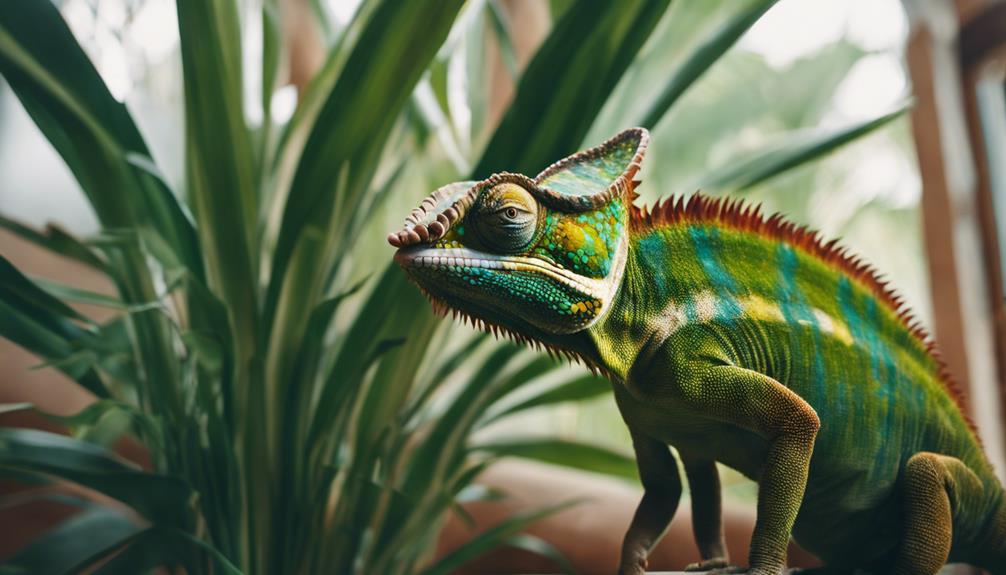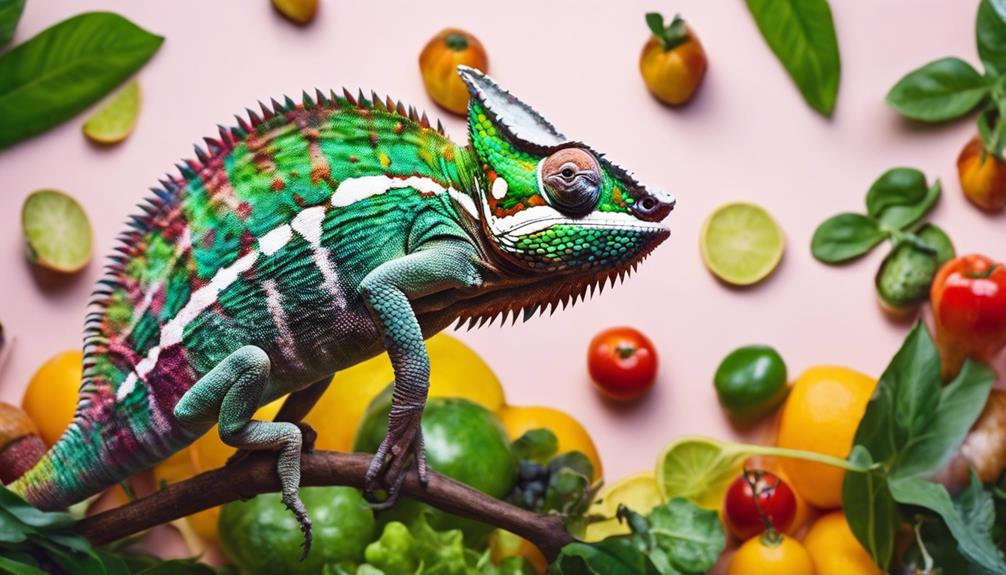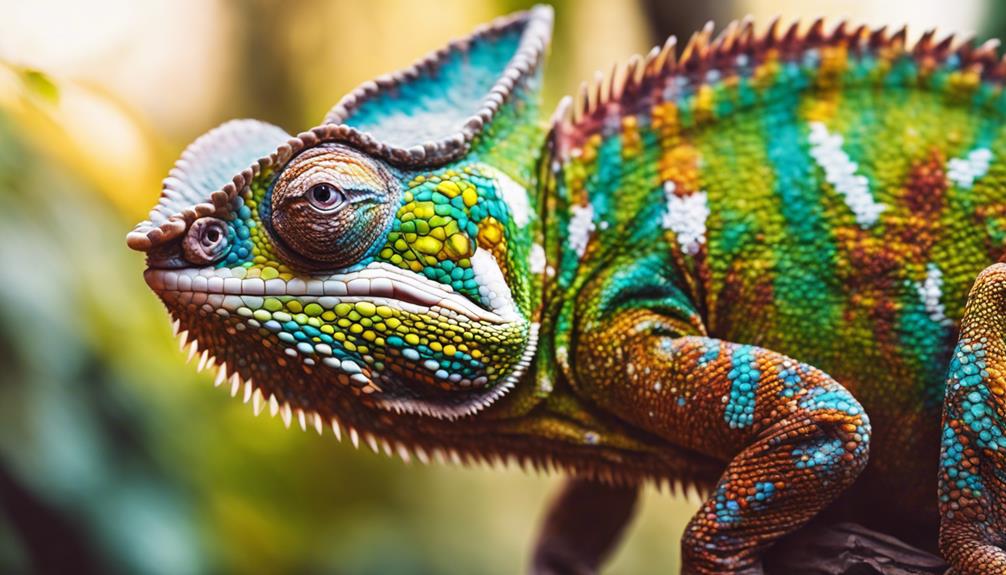When it comes to chameleons and ponytail palms, it's like mixing oil and water – they simply don't blend well together.
However, before making a final decision, it's important to take into account all aspects of the potential risks involved.
So, why might ponytail palms not be the best choice for your chameleon's habitat?
Let's unravel the intricacies and explore the factors at play in this delicate balance of safety and well-being.
Benefits of Ponytail Palms for Chameleons
Ponytail palms offer chameleons a range of benefits within their enclosures, enhancing both the visual aesthetics and environmental enrichment for these arboreal reptiles. These plants provide climbing opportunities for chameleons, mimicking their natural habitat and promoting physical activity. Moreover, ponytail palms aid in maintaining suitable humidity levels in the terrarium, which is vital for the well-being of chameleons, as they require specific environmental conditions to thrive.
The unique aesthetic of ponytail palms with their long, flimsy leaves and twisted trunks not only creates a visually pleasing enclosure but also stimulates the chameleons' natural behaviors. While the plants aren't toxic to chameleons, it's essential to exercise caution due to the presence of sharp leaf edges that could potentially cause harm. When considering the suitability of ponytail palms for chameleons, the numerous benefits they offer regarding enrichment and environmental enhancement must be weighed against the risks associated with their sharp edges.
Risks Associated With Ponytail Palms
What're the specific dangers that chameleons face when exposed to ponytail palms within their enclosures?
Ponytail palms present risks to chameleons due to the sharp edges of their leaves, resembling razor blades, which can cause cutting injuries to these delicate creatures. Chameleons may inadvertently brush against or attempt to climb on these sharp leaf edges, leading to lacerations or wounds.
Additionally, the structure of ponytail palms isn't conducive to chameleons' natural behavior, as they lack suitable perching spots, potentially causing discomfort or stress to the animals.
Additionally, there's a concern for poisoning if chameleons ingest any part of the ponytail palm leaves, as some plants can be toxic to reptiles. Considering these risks, it's important to prioritize the safety of chameleons by opting for plant alternatives that are safer and more suitable for their enclosures, thereby minimizing the potential harm posed by ponytail palms.
Tips for Safely Introducing Ponytail Palms
When considering the introduction of ponytail palms into chameleon enclosures, it's important to carefully assess potential risks and take necessary precautions to guarantee the safety of these delicate reptiles. Here are some tips for safely introducing ponytail palms to make certain the well-being of your Veiled chameleon:
- Monitor Closely: Keep a close eye on your chameleon when near ponytail palms to prevent potential injuries from the sharp leaf edges.
- Choose Safe Plants: Consider replacing ponytail palms with safer plant options that don't pose cutting risks to your chameleon.
- Provide Suitable Perching: Prioritize chameleon-safe plants that offer suitable perching spots for your chameleon to rest on comfortably.
- Offer Climbing Opportunities: Be certain that the plants in the chameleon cage provide adequate climbing opportunities without sharp edges that could harm your pet.
Maintaining a Healthy Environment
To maintain a healthy environment for your chameleon, prioritize selecting plant options that are safe, non-toxic, and conducive to their habitat needs. When choosing plants, refer to safe plant lists specifically curated for chameleons to ensure you provide a secure environment.
Opt for non-toxic leafy greens or vines that offer hiding spots and perching opportunities while avoiding plants with sharp edges or toxic properties. Creating an important environment is key, and selecting plants that thrive in such conditions can help regulate humidity levels within the chameleon's enclosure.
Regular plant care, including monitoring for any signs of wilting or decay, is essential to maintain a safe and comfortable habitat. Remember to stay away from plants like ponytail palms, which may pose risks to your chameleon's well-being.
Alternatives to Ponytail Palms
Consider incorporating safer plant alternatives like Golden Pothos, Ficus Plants, or Areca Palm into chameleon enclosures as replacements for Ponytail Palms. When choosing plants for your chameleon's habitat, opt for varieties that are non-toxic, comfortable for perching, and provide a secure environment. Here are some suitable alternatives to Ponytail Palms:
- Golden Pothos: A hardy vine plant that's non-toxic and easy to care for, making it an excellent choice for chameleon habitats.
- Ficus Plants: Known for their lush foliage and non-toxic properties, Ficus Plants offer a comfortable and secure environment for chameleons.
- Areca Palm: With its graceful fronds and non-toxic nature, the Areca Palm is a safe option that adds a touch of greenery to the enclosure.
- Rubber Plant: This plant is non-toxic and provides a secure perching spot for chameleons, enhancing their well-being in the absence of Ponytail Palms.
Frequently Asked Questions
Are Ponytail Palms Toxic to Pets?
Ponytail palms are generally safe for pets like birds, cats, and dogs. However, there may be concerns about plant toxicity for chameleons. When it comes to pet safety, taking into account potential risks and plant precautions is crucial.
What Plants Are Toxic to Chameleons?
Poisonous plants can pose risks to chameleons, affecting their health. Chameleon safety hinges on avoiding toxic vegetation like Philodendrons. Prioritize their well-being by steering clear of harmful flora in their habitat. Proper plant selection is key for chameleon care.
What Plants Are Good for Chameleons?
For chameleons, non-toxic plants like Golden Pothos and Areca Palm create a tropical paradise in their enclosures. Climbing vines, hanging baskets, and moist habitats cater to their arboreal nature. Edible flowers and leafy greens enrich their diet, while UVB lighting supports their well-being.
Do Ponytail Palms Get Spider Mites?
To prevent spider mites on ponytail palms, employ integrated pest management. Regularly inspect plants, use natural predators, and maintain plant health. Companion plants can deter pests, while organic treatments and DIY solutions offer effective pest control.
Conclusion
To sum up, ponytail palms aren't safe for chameleons due to potential poisoning and injury risks.
Have you considered the well-being of your chameleon when choosing plants for their habitat?
It's essential to prioritize their health and safety by selecting chameleon-friendly plants to create a suitable environment for them to thrive.
Make informed choices to guarantee the best care for your chameleon companion.


